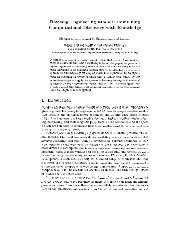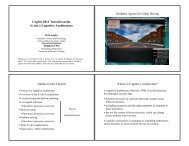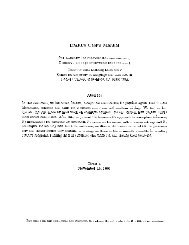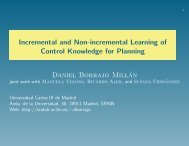Hierarchical Skills and Cognitive Architectures - Computational ...
Hierarchical Skills and Cognitive Architectures - Computational ...
Hierarchical Skills and Cognitive Architectures - Computational ...
Create successful ePaper yourself
Turn your PDF publications into a flip-book with our unique Google optimized e-Paper software.
power law follows from the construction of the hierarchy<br />
itself, which we discuss later. This account also makes<br />
different predictions than traditional schemes about the<br />
number of cycles, <strong>and</strong> thus the time, required to accomplish<br />
tasks with hierarchical <strong>and</strong> recursive structures.<br />
Again, we can use multi-column subtraction to illustrate<br />
this point. A st<strong>and</strong>ard production-system model<br />
for this domain, like that described by Langley <strong>and</strong> Ohlsson<br />
(1984), finds the difference between two numbers in<br />
a column when the top one is larger but otherwise adds<br />
a goal to process or borrow from the adjacent column.<br />
Analysis reveals that such a model will take 5 · b + 2 · n<br />
cycles to complete a problem with b columns that require<br />
borrowing <strong>and</strong> n columns that do not. In contrast, the<br />
Icarus model in Table 1 requires 3·b+2·n cycles on the<br />
same problems. The two frameworks both indicate that<br />
solution time will increase with the number of borrow<br />
columns, but they predict quite different slopes.<br />
Experiments with human subjects should reveal which<br />
alternative offers a better explanation of skilled behavior<br />
in this arena. We have not yet carried out such studies,<br />
but to test our framework’s generality, we have developed<br />
Icarus models for behavior in other domains<br />
that appear to have hierarchical organizations. One involves<br />
the well-known Tower of Hanoi puzzle, which can<br />
be solved using a hierarchical strategy. Our model for<br />
behavior on this task includes three primitive skills for<br />
lifting, lowering, <strong>and</strong> moving a disk sideways, along with<br />
one high-level skill for moving a disk to a target peg that,<br />
in two expansions, calls itself recursively. However, the<br />
Tower of Hanoi is like subtraction in that the environment<br />
changes only when the agent takes some action.<br />
To ensure that Icarus can also support behavior in<br />
more dynamic domains, we have developed two additional<br />
models. One involves hierarchical skills for balancing<br />
an upright pole by moving its lower end back<br />
<strong>and</strong> forth. This system includes two high-level skills with<br />
knowledge about the order in which the four primitive<br />
skills should be invoked. As described elsewhere (Choi<br />
et al., in press), we have also constructed a system that<br />
drives a vehicle <strong>and</strong> delivers packages in a simulated incity<br />
environment. This model includes 46 skills that are<br />
organized in a hierarchy five levels deep. The high-level<br />
skills let the agent drive straight in lanes, get into rightmost<br />
lanes, slow for intersections, drive through intersections,<br />
turn at intersections, <strong>and</strong> make U turns. These<br />
terminate in actions for changing speed <strong>and</strong> altering the<br />
wheel angle. Another 13 skills support the delivery of<br />
packages to target addresses.<br />
We have not attempted to compare the details of these<br />
systems’ operations to human behaviors on the same<br />
tasks. Nor have we attempted to show that Icarus produces<br />
more robust behavior than programs cast in earlier<br />
frameworks like Soar <strong>and</strong> ACT-R. Rather, our goal has<br />
been to demonstrate the same broad functionality as we<br />
observe in humans, including their apparent organization<br />
of complex skills into hierarchies. We have also aimed to<br />
show that Icarus constitutes a viable point in the space<br />
of cognitive architectures, which we believe has been too<br />
thinly explored to date.<br />
Related Efforts <strong>and</strong> Future Research<br />
Although Icarus incorporates a number of features that<br />
distinguish it from typical cognitive architectures, some<br />
related ideas have appeared elsewhere under different<br />
guises. For instance, our framework has much in common<br />
with the ‘reactive planning’ movement, which often<br />
utilizes hierarchical procedures that combine cognition,<br />
perception, <strong>and</strong> action in physical domains. 2 Examples<br />
include PRS (Georgeoff et al., 1985), teleoreactive programs<br />
(Nilsson, 1994), <strong>and</strong> the 3T robotic architecture<br />
(Bonasso et al., 1997), <strong>and</strong> some case-based planners<br />
(e.g., Hammond, 1993) embody similar notions.<br />
However, within this paradigm, only Freed’s (1998)<br />
APEX has been proposed as a c<strong>and</strong>idate architecture for<br />
human cognition. This framework shares Icarus’ commitment<br />
to hierarchical skills, but it has a more procedural<br />
flavor <strong>and</strong> it does not incorporate a separate conceptual<br />
memory or enforce a correspondence between longterm<br />
<strong>and</strong> short-term structures. Another kindred spirit<br />
is Albus <strong>and</strong> Meystel’s (2001) RCS architecture, which<br />
organizes knowledge hierarchically <strong>and</strong> makes a clear distinction<br />
between logical structures <strong>and</strong> value judgments.<br />
Icarus <strong>and</strong> RCS share many common features, but they<br />
also retain many differences due to their origins in cognitive<br />
modeling <strong>and</strong> control theory, respectively.<br />
We should clarify that, as a cognitive architecture,<br />
Icarus still requires some development. The framework<br />
lacks many processing assumptions that would make it<br />
more plausible as a general theory of human behavior.<br />
For instance, it lacks any limits on perceptual b<strong>and</strong>width<br />
that require attention, which arises even on routine tasks<br />
like subtraction. We intend to model such behavior by<br />
introducing an action that focuses the agent’s attention<br />
on an object <strong>and</strong> deposits its description in the perceptual<br />
buffer, with Icarus being able to apply this action<br />
to only one visible object per cycle. This should produce<br />
longer subtraction runs that require additional steps for<br />
attentional events, much as in Anderson, Matessa, <strong>and</strong><br />
Lebiere’s (1997) ACT-R model of visual attention.<br />
We should also extend our models for subtraction<br />
<strong>and</strong> other domains to h<strong>and</strong>le lower levels of behavior<br />
more faithfully. The skills in Table 1 terminate with actions<br />
for decrementing, adding ten, <strong>and</strong> finding a difference,<br />
but these can be further decomposed into subskills<br />
for writing specific digits <strong>and</strong> even drawing individual<br />
lines. Our claim to model embodied cognition would be<br />
stronger if we extended the skill hierarchy downward in<br />
this fashion. We should also extend the hierarchy upward<br />
to model choices about which problem to tackle<br />
when many are present on the page. Such an exp<strong>and</strong>ed<br />
system would model subtraction behavior in a more complete<br />
way than do most accounts.<br />
However, a more important omission concerns the origin<br />
of Icarus’ hierarchical skills. To h<strong>and</strong>le this, we<br />
hypothesize a mechanism that is related to chunking in<br />
Soar <strong>and</strong> production composition in earlier versions of<br />
ACT. Although humans prefer to use routine behaviors<br />
when possible, they can, within limits, combine<br />
2 Our model of subtraction skills also has similarities to<br />
VanLehn’s (1990) hierarchical treatment of this domain.







